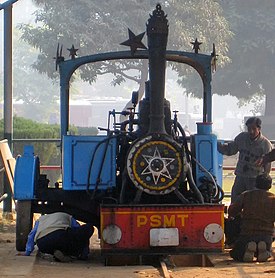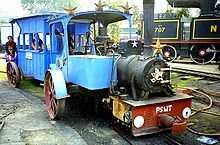Patiala State Monorail Trainways
| Patiala State Monorail Trainways | |
|---|---|
|
Steam locomotive in the National Rail Museum of India
| |
| Route length: | 80 km |
The Patiala State Monorail Trainways ( PSMT ) built and operated from 1907 to 1927 with steam engines a unique monorail in Patiala in British India , in the Punjab , in the northeast of present-day India .
history

The Patiala State Monorail Trainways built the world's only steam-powered monorail that used the Ewing system developed by William Thorold (1798–1878) . The system had already proven itself in 1902–1908 on the Kundala Valley Railway , which had been built before , but whose cars were pulled by oxen before it was converted into a conventional narrow-gauge railway in 1908. There were several monorails in India at times, but when it was closed in 1927 it was the only remaining monorail in India. After that, there were only two more monorails in India until the Mumbai Monorail opened on February 2, 2014. A steam locomotive built in Germany and a passenger car have been preserved and will be demonstrated on Sundays in the National Rail Museum of India in New Delhi .
Maharaja Sir Bhupinder Singh of Patiala commissioned the construction of this unique monorail for passenger and freight traffic. The engineer in charge was Colonel CW Bowles , who had previously laid a monorail constructed according to the Ewing system for the transport of materials during the construction of the Bengal Nagpur Railway . Before the use of steam locomotives, trains were pulled by mules and oxen.
Route
The route network was about 80 km (50 miles) long. It consisted of two unconnected routes. The one 24 km long route led from Sirhind station to Morinda . It was supposed to be extended to Ropar , but the plans were discarded after Ropar became accessible by rail. The other 56 km stretch led from Patiala to Sunam .
The steam locomotive was probably only used on the route from Patiala to Sunam. Since the locomotive was too heavy for the 18 lb / yd (approx. 9 kg / m) heavy rails, it was probably only used on the 1.6 km long section from Patiala Station to City Mandi. More stable rails with 60 lb / yd (approx. 30 kg / m) for this section of the route were stored together with other mothballed equipment in the depot of the monorail.
Superstructure
The rails were laid by Marsland & Price from Bombay . They weighed 18 lb / yd (about 9 kg / m) and were clipped onto iron sleepers measuring 10 × 8 × ½ inches (254 × 203 × 12.7 mm). On the Patiala – Sunam route, wooden sleepers measuring 15 × 3 × 4 inches (381 × 76 × 101 mm) were initially used, but were later replaced by iron sleepers because of the termite damage .
Advantages and disadvantages of the Ewing system

The railways equipped with the Ewing system are essentially monorails with a lateral support wheel running on the road. Most of the forces (around 95%) are transmitted via the low-friction metal rail, while the rest is diverted via the support wheel.
The investment costs for the expensive, imported metal rails are halved when building a monorail. In addition, the rails of conventional parallel tracks must be aligned at almost the same height to prevent derailment . This is not necessary with a monorail, which minimizes construction and maintenance costs. The monorail could be laid along existing tar or macadam roads in a very space-saving and cost-effective manner, with the support wheels running on the existing road. In this case, the vehicles were not turned at the terminal stations.
A monorail can run through much smaller radii than narrow-gauge or standard- gauge railways . The Patiala State Monorail Trainways drove through a very densely populated metropolitan area with frequent traffic congestion without permanently affecting road traffic.
Depending on the condition of the road on which the support wheel was running, the uneven running and the risk of derailment proved to be disadvantageous. Since the weight of the monorail steam locomotives was distributed on only 3 wheels instead of six wheels, as is the case with a narrow-gauge railway locomotive, and due to the contact of the wheel flanges with the rails, the rails were severely worn.
Locomotives
After draft animals were initially used for the trains, four steam locomotives were later imported from Germany. The three-axle 0-3-0 locomotives (C-Couplers) were delivered in 1907 by Orenstein & Koppel (O&K) of Berlin at a price of £ 500 to £ 600. It was a matter of converting normal six-wheeled 0-6-0 narrow-gauge locomotives, but the monorail locomotives each had a drive wheel with two flanges and a diameter of 500 mm in the middle of the front and rear axles. The groove between the wheel flanges was 21.5 mm deep. The wheel on the middle axle had no flanges. The locomotive had a wheelbase of 1190 mm. The water tank was slightly larger on the right-hand side than on the left-hand side in order to adequately load the support wheel with a diameter of 990 mm, which was attached to the right-hand side under the water tank. The cylinders were 5½ x 14 inches .
Locomotives with internal combustion engines were also used on a trial basis.
dare
- In 1908 there were 75 freight cars and 15 passenger cars.
- Most of the wagons were about eight feet by six feet, with two wheels eight inches in diameter, about eight feet long and about eight feet . The car's support wheel was 980 mm in diameter at a distance of 2133 mm (7 feet) from the rail.
- The passenger cars were open at the sides with bench seats arranged back to back.
- There were also some 30 foot (9.14 m) long freight cars with two support wheels each. Some of them were converted into passenger cars with built-in transverse benches.
Traffic volume and fares
In September 1907, 20,000 passengers per month were transported on the Sirhind – Morinda route. The fare was 1½ annas for the entire route. Freight was carried for 1 anna per mouth (37.4 kg).
Shutdown
Around 1912, the monorail lost its popularity due to increasing road traffic. It was temporarily taken out of service and mothballed on October 1, 1927.
Rediscovery and exhibition
The mothballed monorail was found in a shed belonging to the Public Work Department (PWD) in 1962 . Locomotive No. 4 and the Chief Engineer's Private Inspection Car have been restored and exhibited in working order at the National Rail Museum of India in New Delhi . The steam locomotive is regularly heated up and demonstrated on Sundays and on special occasions.
Individual evidence
- ↑ a b Patiāla State: Trade and Communications . In: Henry Frowd (ed.): Imperial Gazetteer of India , Volume 20. Clarendon Press, Oxford a. a., 1908, p. 44, accessed on December 27, 2017 (English): "A mono-tramway opened in February, 1907 connects Basi with railway at Sirhind."
- ^ A b John Robert Day, Brian Geoffrey Wilson: Unusual railways . Muller, London, 1957 (?), LCCN 58-027405 .
- ^ Memoirs of Deceased Members . In: Minutes of Proceedings of the Institution of Civil Engineers . 55, No. 1879, 1879, pp. 321-322. doi : 10.1680 / imotp.1879.22399 .
- ^ Frederick Arthur Ambrose Talbot: Cassell's Railways of the World . The Waverley Book Company, London, 1924, LCCN 28-030210 .
-
↑ Samyabrata Ray Goswami: Mumbai gawks as train chugs overhead . The Telegraph (Calcutta), February 19, 2013, accessed December 27, 2017.
Tea - A Cup of Life. (pdf; 1.8 MB) In: Sands of Time. Newsletter of Tata Central Archives. Volume V, Issue 1, January 2006, pp. 5-7 , archived from the original on July 19, 2008 ; accessed on December 27, 2017 (English). - ↑ List of monorails in India on the Families In British India Society (Fibis) website.
- ^ A b c Henry Reason Ambler: An Indian “Might-Have-Been”. The Railway Magazine, February 1969, archived from the original on July 11, 2017 ; accessed on December 27, 2017 (English).
- ↑ a b Patiala State Monorail Train (PSMT). National Rail Museum, archived from the original on May 9, 2008 ; accessed on December 27, 2017 (English).
Coordinates: 30 ° 21 ' N , 76 ° 24' E





